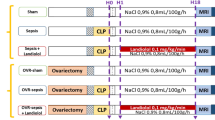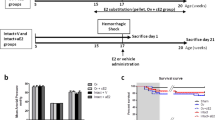Abstract
The incidence of obesity is on the rise in most western countries and represents major risks to health. Obesity causes complex metabolic dysfunctions and can be associated with a large number of secondary diseases. To investigate causal mechanisms of obesity and develop better options for treatment, researchers study the condition in animal models. In addition to genetically engineered animal models, diet-induced obesity is often used because it occurs similarly in animals as it does in humans. For several types of investigations that use obesity models, investigators must carry out surgical interventions and they frequently encounter severe perioperative complications induced by anesthesia. In an example of this problem, we observed 100% mortality in obese BALB/c mice after ovariectomy, despite no obvious surgical complications. We supposed that a failure to recover from surgery was the primary cause of this increased mortality. Therefore, to support their recovery from surgery we administered atropine to obese mice in order to facilitate blood circulation, and we also increased the oxygen content of the ambient air. With this specific support before and after surgery, we increased the survival rate of obese ovariectomized mice up to 83%. These results confirm the assumption that obesity is a risk factor for the recovery of obese animal models after ovariectomy, and they highlight the need to provide additional interventions for such experimental animals.
This is a preview of subscription content, access via your institution
Access options
Subscribe to this journal
We are sorry, but there is no personal subscription option available for your country.
Buy this article
- Purchase on Springer Link
- Instant access to full article PDF
Prices may be subject to local taxes which are calculated during checkout





Similar content being viewed by others
References
WHO. Obesity: preventing and managing the global epidemic. Report of a WHO consultation. World Health Organ. Tech. Rep. Ser. 894, 1–253 (2000).
Michel, K.E., Fascetti, A. & Delany, S.J. in Applied Veterinary Clinical Nutrition (eds. Fascetti, A. & Delany, S.J.) 109–124 (John Wiley & Sons Ltd., West Sussex, UK, 2012).
Blüher, M. Adipose tissue dysfunction in obesity. Exp. Clin. Endocrinol. Diabetes 117, 241–250 (2009).
Trayhurn, P. & Wood, I.S. Signalling role of adipose tissue: adipokines and inflammation in obesity. Biochem. Soc. Trans. 33, 1078–1081 (2005).
Blüher, M. Adipokines—removing road blocks to obesity and diabetes therapy. Mol. Metab. 3, 230–240 (2014).
Bianchini, F., Kaaks, R. & Vainio, H. Overweight, obesity and cancer risk. Lancet Oncol. 3, 565–574 (2002).
Trentham-Dietz, A. et al. Weight change and risk of postmenopausal breast cancer (United States). Cancer Causes Control 11, 533–542 (2000).
MacLean, P.S. et al. A surprising link between the energetics of ovariectomy-induced weight gain and mammary tumor progression in obese rats. Obesity (Silver Spring) 18, 696–703 (2010).
Mathis, M.R. et al. Patient selection for day case-eligible surgery. Anesthesiology 119, 1310–1321 (2013).
Brodbelt, D.C., Pfeiffer, D.U., Young, L.E. & Wood, J.L.N. Results of the confidential enquiry into perioperative small animal fatalities regarding risk factors for anesthetic-related death in dogs. J. Am. Vet. Med. Assoc. 233, 1096–1104 (2008).
Love, L. & Cline, M.G. Perioperative physiology and pharmacology in the obese small animal patient. Vet. Anaesth. Analg. 42, 119–132 (2015).
Burnside, W.M., Flecknell, P.A., Cameron, A.I. & Thomas, A.A. A comparison of medetomidine and its active enantiomer dexmedetomidine when administered with ketamine in mice. BMC Vet. Res. 9, 48 (2013).
Taylor, R., Hayes, K.E. & Toth, L.A. Evaluation of an anesthetic regimen for retroorbital blood collection from mice. Contemp. Top. Lab. Anim. Sci. 39, 14–17 (2000).
Zuurbier, C.J., Emons, V.M. & Ince, C. Hemodynamics of anesthetized ventilated mouse models: aspects of anesthetics, fluid support, and strain. Am. J. Physiol. Heart Circ. Physiol. 282, H2099–H2105 (2002).
Bennett, G.J. Update on the neurophysiology of pain transmission and modulation: focus on the NMDA-receptor. J. Pain Symptom Manage. 19, S2–S6 (2000).
Maze, M. & Tranquilli, W. Alpha-2 adrenoceptor agonists: defining the role in clinical anesthesia. Anesthesiology 74, 581–605 (1991).
Sinclair, M.D. A review of the physiological effects of alpha2-agonists related to the clinical use of medetomidine in small animal practice. Can. Vet. J. 44, 885–897 (2003).
Brock, K.A. Preanaesthetic use of atropine in small animals. Aust. Vet. J. 79, 24–25 (2001).
Baker, N.J., Schofield, J.C., Caswell, M.D. & McLellan, A.D. Effects of early atipamezole reversal of medetomidine-ketamine anesthesia in mice. J. Am. Assoc. Lab. Anim. Sci. 50, 916–920 (2011).
Veilleux-Lemieux, D., Castel, A., Carrier, D., Beaudry, F. & Vachon, P. Pharmacokinetics of ketamine and xylazine in young and old Sprague-Dawley rats. J. Am. Assoc. Lab. Anim. Sci. 52, 567–570 (2013).
Cruz, J.I., Loste, J.M. & Burzaco, O.H. Observations on the use of medetomidine/ketamine and its reversal with atipamezole for chemical restraint in the mouse. Lab. Anim. 32, 18–22 (1998).
Cheymol, G. Effects of obesity on pharmacokinetics implications for drug therapy. Clin. Pharmacokinet. 39, 215–231 (2000).
Hanley, M.J., Abernethy, D.R. & Greenblatt, D.J. Effect of obesity on the pharmacokinetics of drugs in humans. Clin. Pharmacokinet. 49, 71–87 (2010).
Guh, D.P. et al. The incidence of co-morbidities related to obesity and overweight: a systematic review and meta-analysis. BMC Public Health 9, 88 (2009).
Steier, J., Lunt, A., Hart, N., Polkey, M.I. & Moxham, J. Observational study of the effect of obesity on lung volumes. Thorax 69, 752–759 (2014).
Salome, C.M., King, G.G. & Berend, N. Physiology of obesity and effects on lung function. J. Appl. Physiol. 108, 206–211 (2010).
Mosing, M. et al. Oxygenation and ventilation characteristics in obese sedated dogs before and after weight loss: a clinical trial. Vet. J. 198, 367–371 (2013).
Wang, Z., Li, L., Zhao, H., Peng, S. & Zuo, Z. Chronic high fat diet induces cardiac hypertrophy and fibrosis in mice. Metabolism 8, 917–925 (2015).
Callaghan, L.C. & Walker, J.D. An aid to drug dosing safety in obese children: development of a new nomogram and comparison with existing methods for estimation of ideal body weight and lean body mass. Anaesthesia 70, 176–182 (2015).
Cortínez, L.I. et al. Performance of propofol target-controlled infusion models in the obese: pharmacokinetic and pharmacodynamic analysis. Anesth. Analg. 119, 302–310 (2014).
Lemmens, H.J. Perioperative pharmacology in morbid obesity. Curr. Opin. Anaesthesiol. 23, 485–491 (2010).
Sankaralingam, S., Kim, R.B. & Padwal, R.S. The impact of obesity on the pharmacology of medications used for cardiovascular risk factor control. Can. J. Cardiol. 31, 167–176 (2015).
Jones, P., Dauger, S. & Peters, M.J. Bradycardia during critical care intubation: mechanisms, significance and atropine. Arch. Dis. Child. 97, 139–144 (2012).
Acknowledgements
We thank Anette Molzahn for her support during the development of the atropine injection regimen. The study was supported by the Danone Foundation, Haar, Germany.
Author information
Authors and Affiliations
Corresponding author
Ethics declarations
Competing interests
The authors declare no competing financial interests.
Rights and permissions
About this article
Cite this article
Mattheis, L., Jung, JS., Hiebl, B. et al. Perioperative support reduces mortality of obese BALB/c mice after ovariectomy. Lab Anim 45, 262–267 (2016). https://doi.org/10.1038/laban.1042
Received:
Accepted:
Published:
Issue Date:
DOI: https://doi.org/10.1038/laban.1042



